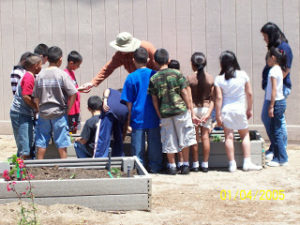School gardens can be used in curriculum in so many creative ways. One of the most obvious ways to teach using a garden is in the Sciences subjects. Life, earth and physical sciences can all be taught in the garden. Here are a few examples of life science teaching opportunities taken from the California School Garden Network’s “Garden for Learning” book.

A teaching moment from one of our grant recipients: Poplar Elementary in Fontana.
– Have students differentiate between living and non-living things.
– Have students compare and contrast humans with plants.
– Have students examine how plants grow, examine life cycles of plants with fast growers like sunflowers.
– Students can examine what plants need to grow(don’t forget about water!) and the different things different plants need.
– Plants have different parts: roots, leaves, stems, flowers, fruit, seeds, students can examine what each part is for, and why each part looks like it does or is located where it is.
– Plants have certain characteristics that are inherited, but what about different characteristics because of their environment. Do some do better in full sun? What about with less or more water?
– Talk about photosynthesis and how plants convert sunlight into energy, (this is also a great way to talk about how scientists used this idea to create solar panels)
– Teach about how plants have adapted. The different shaped and colored flowers so that certain animals can pollinate them. The different types of seeds so that they can travel and reseed in other places. The different ways that they grow for different reasons.
